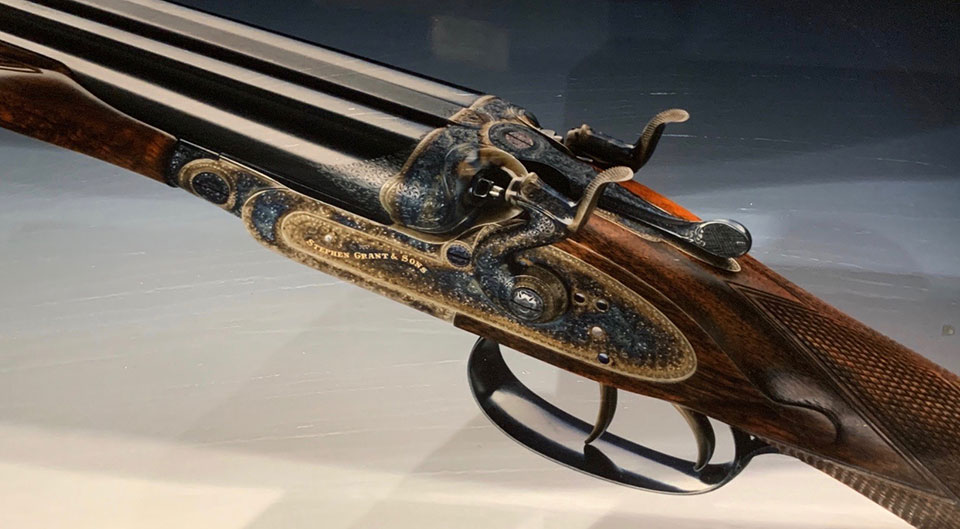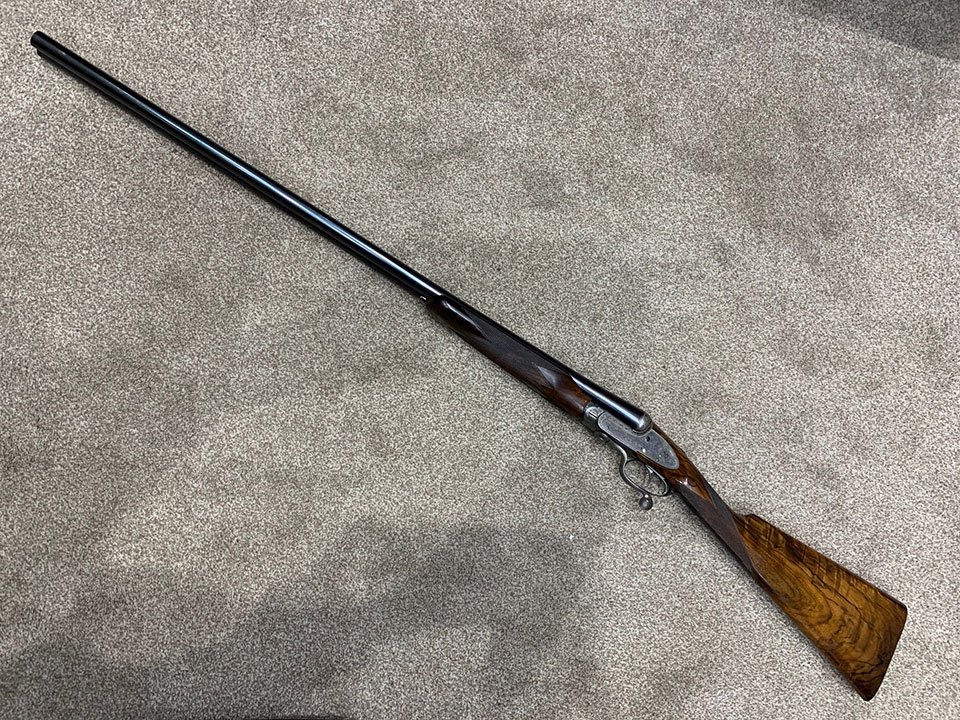“I find it hard to imagine that anybody shoots nowadays with a pair of hammerguns . . . .” —Gough Thomas, from 'The Gun Book', August 1967.
When Cyril Adams began shooting British guns in the 1970s—and then later restoring and selling them—not only did scarcely anyone shoot a pair of hammerguns, barely anyone shot hammerguns at all. Guns with Damascus barrels were widely perceived as inherently unsafe in the US, and long-barreled pigeon guns were considered little more than quaint relics. Chamber sleeving—that is, boring out and then lining the chamber area of a barrel with a smaller-bore, modern-steel sleeve—was unheard of. The British gun trade had spent the decade imploding, leaving only a handful of survivors in London and Birmingham making new "best” guns.
How things have changed. By the late ’90s, hammerguns had become all the rage, pigeon guns had gotten pricey, long barrels had become de rigueur on side-by-sides, and the British trade was renascent—with a bevy of old makers resurrected and again building best guns. There was even an American organization—The Order of Edwardian Gunners—that had sprung into being promoting the virtues of traditional British guns and hosting The Vintage Cup, “The World Side-by-Side Championships & Exhibition.”
It would be hard to imagine any of this occurring without a Texan named Cyril Adams.
Here I’ll examine the two guns Adams built for himself when he owned London’s Atkin Grant & Lang, with an eye specifically to how they ex-emplify his predilections (he might call them “prejudices”) for fine guns—predilections he has helped popularize over the past quarter century.
Both guns are Stephen Grants, Adams’ clear favorite in the trio of gunmakers he once owned. Though today Grant does not possess quite the cachet of Purdey, Boss, Holland & Holland or Woodward, in the gunmaker’s prime—the 1860s to about 1900—Grant was unquestionably their equal in the marketplace and prestige. The firm held a royal warrant from the Prince of Wales (and later King Edward VII) and counted among its clients the nobility and aristocracy of Britain and the Continent.
Most of the guns built under Adams’ ownership of AG&L were Grants (with a handful of Atkins built as self-openers and Langs as less-expensive guns), and it was natural that he would choose the Grant name for guns of his own.
The first, Stephen Grant Serial No. 24028, is almost as legendary as its owner. Dubbed “Supergun,” 24028 is a 12-gauge, eight-pound hammergun completed in 1995 and built specifically for live-pigeon trapshooting and Helice. Adams used it to take second place in the 1998 World Helice Championship. He uses it regularly to shoot the pants off of younger hotshots toting modern Italian over/unders.
To be a good pigeon shooter you have to be lightning fast and deadly accurate...
Supergun started life more than a century ago as a bar action with a toplever, hidden third bite and sideclips. For whatever reason it was never finished; the barrels and action came to Adams at AG&L in the white bearing London proof marks but no name or clue as to its original maker. In the robust action Adams saw the perfect chassis for a new bespoke version of the vintage guns he was shooting—a long-barreled yet relatively light, well-balanced gun that would allow its owner to be quick onto the bird yet would provide a smooth, controlled swing. “To be a good pigeon shooter you have to be lightning fast and deadly accurate,” Adams said of his pigeon-gunning philosophy. “Lightning fast comes from good balance, and deadly accurate comes from smoothness.”
More so than any other design, British pigeon hammerguns ticked both of the boxes for Adams. In his book Lock, Stock and Barrel, Adams elucidated the arguments for the external-hammer design: “When hammers are concealed in hammerless guns, the action body must necessarily be larger both in width and depth. In fact it must be significantly larger. The larger action changes the dimensions of the head of the stock and the relation of the trigger hand to the bore of the barrels. In addition, the hollow hammerless action is lighter than the solid hammergun for guns of comparable size, which means that the stock and barrels must be made heavier to attain a prescribed weight. This weight distribution is a movement away from the hands as opposed to between them, which detracts from the liveliness of the gun . . . . Hammerguns, because of weight-design flexibility, can also accommodate long barrels more easily.”

Supergun was fitted with long, hand-filed 34-inch barrels that provided a long sighting plane and the inertia for a smooth swing but were light enough to promote lively handling. Because of the high financial stakes involved—in prize money and in side bets and calcuttas—live-pigeon trapshooters have historically been on the forefront of shotgun-shooting technology, from choke boring to propellant and shotshell development, even gun design (in modern times think Perazzi and Fabbri). All of these aspects of shooting have been winnowed by the demands of competitors shooting for purses in the hundreds of thousands of dollars.
Based on what I was seeing, I forecast that barrels were going to get longer.
Adams analyzed not only what he succeeded with, but also what worked for the world’s best pigeon and Helice shooters. A common constant among them was long barrel length. “Based on what I was seeing,” Adams said. “I forecast that barrels were going to get longer. The day of the 28-inch-or-shorter barrel was over.” When restoring guns for resale, he would sleeve guns with bad barrels with longer tubes.
Today shotgunners in almost all of the clay-target disciplines favor long barrels, and even in the game fields short-barreled doubles popular as late as the 1980s are now badly out of fashion. Adams cannot be credited entirely for causing the pendulum swing: The growth of sporting clays—and in England the popularity of “tall” (high) driven pheasants—certainly deserves credit, but as an influential advocate and gunmaker he was well ahead of the herd.
The second gun Adams had built for himself—Stephen Grant No. 24055—exemplifies Adams at his most influential and also at his most unorthodox. A bar-in-wood sidelever sidelock, it has 30-inch Damascus barrels that have been chamber sleeved from their original 16-gauge dimensions to 20 gauge. Engraved with Grant-style fine scroll by Keith Thomas it is without question one of the most fascinating new best British guns I’ve examined.
Adams built the gun around a set of tubes taken from a vintage 16-bore sidelock that had failed reproof. (The Damascus had easily stood the strain of proof, but the action had cracked.) “They were lovely barrels with thick walls and lots of choke,” Adams said.
In large part thanks to Adams’ influence, using in-proof Damascus barrels in America is no longer considered remarkable or risky, but Adams recalled when that was not the case. “When I first started shooting Damascus,” he said, “people looked at me like I was pulling the pin on a grenade every time I fired a shot. You still get that some, but that’s from the people who get all their information on ammunition from the top of a shell box.”
Adams has barrels chamber sleeved and re-proofed in England—a gun-restoration technique he popularized. (He also pushed the London proof house to accept the concept.) Barrels can be chamber sleeved in several ways. For one, they may be sleeved with a modern-steel liner to their original gauge—for example, on a gun with badly pitted or corroded chambers. Or they can be converted to a smaller gauge—for example, a 10-gauge to a 12 or, in the case of Grant 24055, a 16 to a 20. Plastic shotcups from the smaller gauge will obturate in the larger bore—thereby reducing pressure as the gas propelling the charge expands into the bigger tube. Better patterns and less perceived recoil have been credited to the pressure-reducing procedure.
Traditionally, most British smallbores were built for women or boys, and the prevailing thought of the makers at the time was to make them as light as possible—in fact, so light and low in inertia (whippy) that most adults have difficulty shooting them well.
On his hybrid 16-turned-20, Adams tackled this by two methods: first, a longer-than-normal forend to add just a little weight up front; and second (and less conventional), by weighting the barrels under the rib, which he had done on many guns. (This can be accomplished by adding lead or another metal—a brass brazing rod, for example—at select points under the rib to achieve the desired weight and balance.) While I would be hesitant to say that Adams alone invented the barrel-weighting trick, other British makers have followed the example since he began popularizing the technique. Grant 24055 weighs 6 pounds 4 ounces—just a hair forward in its balance but not so much that it still doesn’t dance in your hands.
The sidelever is, of course, a Stephen Grant signature, as are the fluted fences—which in this case Adams paired with an ultra-rare bar-in-wood action. Bar-in-woods are more typically found on hammergun actions—meaning that most have not been made for a long, long time—and Adams had to search far and wide before he found an actioner willing to take on the task of filing up an unfamiliar, archaic design. Brian Gibb was one who would, and Adams provided him with a vintage “wood bar” (as Adams calls them) to serve as a model. Gibbs got it right; the Grant is a stunning example of retro-modern gunmaking.
Hammerguns, pigeon guns, long barrels, Damascus barrels, weighted barrels, chamber sleeves—Grants 24028 and 24055 have it all, and thereby they reflect the influence and legacy of Cyril Adams.

Vic Venters
Published by Vintage Guns Ltd on (modified )




